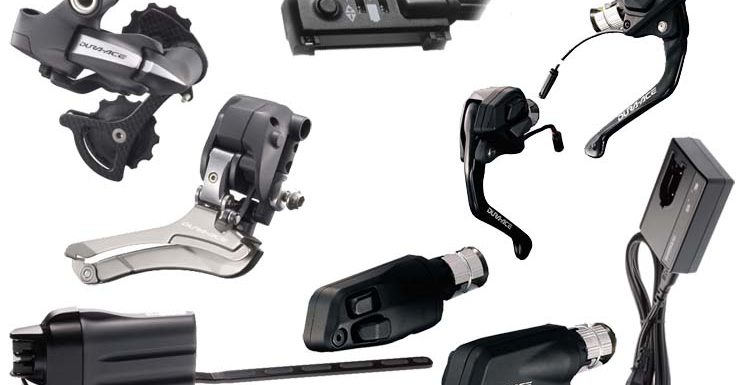
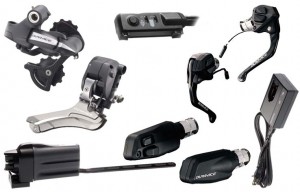 I learned quite a bit about Shimano Di2 when I installed one of the first available Time Trial/Triathlon groupsets on my Cervelo P2. I’ve subsequently answered a lot of questions on forums and article comments, and elsewhere. In doing so, I realized that people have a lot of questions about Di2 and the answers are difficult to find. This lead me to create this article, to consolidate everything I know and have been asked into one location so people can find answers. If you can’t find what you’re looking for below, please leave a comment and I’ll do my best to help.
I learned quite a bit about Shimano Di2 when I installed one of the first available Time Trial/Triathlon groupsets on my Cervelo P2. I’ve subsequently answered a lot of questions on forums and article comments, and elsewhere. In doing so, I realized that people have a lot of questions about Di2 and the answers are difficult to find. This lead me to create this article, to consolidate everything I know and have been asked into one location so people can find answers. If you can’t find what you’re looking for below, please leave a comment and I’ll do my best to help.
Index: There’s lots of info in this post, so here’s an Index to help you find specific sections:
- Di2 General Overview
- Compatibility: Between 6770 10-speed, 6780 11-speed, 9070 11-speed, first-gen 7970
- How to Check Battery Level
- How to Adjust Rear Derailleur Trim
- How to Adjust Front Derailleur Trim
- Dealer Installation Manuals
- Shimano E-tube Project Software – Change Settings and Update Firmware
- Chargers, PC USB Interfaces/Programmers
- Component Overviews
- Shift/Brake Levers
- Dedicated Shift Buttons
- Front Derailleurs
- Rear Derailleurs
- Display Units and ANT Bluetooth Wireless Communication Modules
- Batteries and Battery Mounts (Internal and External)
- Front Cable Connection A Junctions (with charger ports and LED status lights)
- Rear Cable Connect B Junctions
- Cables, Grommets, Cable Install Tools
- List of Components Needed to Build Your Own Di2 System
- Technical Details of the Di2 CANBUS protocol and signaling
System Overview: Shimano Di2 Dura-Ace 9150 and 9070 and Ultegra 6770 and 6870
The second generation Shimano Ultegra 6770/6870 and Dura-Ace 9070 “E-Tube” electronic bicycle shifting systems consist of battery-powered electric derailleurs activated by handlebar mounted push buttons. Power and shift commands are sent via a 2-wire CAN (Controller Area Network) datalink contained within a single cable housing. This design has several advantages over conventional mechanical shifting systems, the most notable of which are:
- Extremely low shifting effort, which generally results in more frequent shifts and therefore better gear ratio selection.
- Greatly improved shift quality, especially for the front derailleur chainrings, allowing shifting under full power with almost no chance of a dropped chain.
- Shifting is available at multiple positions on the handlebars, for example, at the end of the time trial aero bars, on the brake levers, up to in climbing position, and down low the sprint position.
- Automatic trimming of the front derailleur position as the rear derailleur moves back and forth between the smaller and bigger gears. This eliminates unintended contact (and noise) between the front derailleur and the chain.
- Lighter weight vs. equivalent mechanical system. The Shimano Dura-Ace Di2 9070 electronic groupset with internal battery weighs 2047 grams; the Shimano Dura-Ace 9000 mechanical groupset weighs 2074 grams (27 grams more than Di2.)
- Multi-Shift: Pressing and holding a rear derailleur shift button results in shifts through multiple gears. The rate of shifts can be configured using the PC computer interface cable and the free Shimano E-tube Project software.
- Synchronized Shifting: Starting with Dura-Ace 9150, automated Synchronized Sifting of the front derailleur is an option. Two SHIMANO Synchronized Shift modes will be available:
- Full SHIMANO Synchronized Shift: the front derailleur reacts based on the rear derailleur’s shift action. This essentially means that, when activated, there is no need for two separate shifters to control front and rear derailleurs, the two buttons on one shifter will control both derailleurs.
- Semi SHIMANO Synchronized Shift mode: the rear derailleur reacts based on the front derailleur’s shift action, shifting to the next most appropriate rear gear when the rider makes a front shift.
- R9120, R9170 – syncroshift enabled with firmware 3.2.0 or newer
- 6870, 9070 – syncroshift enabled with firmware 3.2.1 or newer
- 6770 – no syncroshift firmware update will be offered
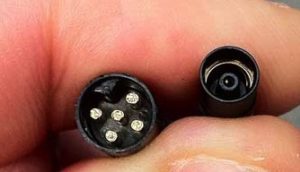 Historic Info on the older first generation 5-wire Shimano Dura-Ace Di2 DA-7970 system and how it compares to the new E-tube 2-wire system:
Historic Info on the older first generation 5-wire Shimano Dura-Ace Di2 DA-7970 system and how it compares to the new E-tube 2-wire system:
Released in 2009, the 7970 operated using a very basic 5-wire electronic system. Each shift button was connected to a different wire; shorting the specific wires together controlled the derailleur upshifts and downshifts. Because the first generation 7970 used completely different technologies than the newer 2-wire systems, none of the components are cross-compatible. At this point, Shimano is not expected to offer any updates or new components using the first generation 7970 architecture; everything from now on will be based on the newer 2-wire E-tube design. The second generation design offers several advantages, which include: 1) smaller wire size, smaller connector size, waterproof connectors; 2) all switches can be reconfigured in software to send upshift or downshift commands to either the front or rear derailleur; 3) firmware updates can add new features (such as multi-shift) and compatibility with new components.
Compatibility: Dura-Ace 9070 and Ultegra 6770 / 6870 (and old 5-conducter 7970)
The confusing naming system used by Shimano makes it difficult to figure out what each component is, much less what is compatible between systems. Here are some compatibility guidelines:
- Nothing from the first generation (4-conductor / 5-conductor) Dura-Ace Di2 7970 system is compatible with any other newer system. It was replaced by the (2-conductor) E-tube systems. No parts are inter-operable between 7970 and any other Di2 System.
- In general, every electronic Di2 component is compatible between the Ultegra 6770, 6870, and Dura-Ace 9070 systems (see exceptions below.) This means that all of the road bike Ultegra/Dura-Ace dual control brake levers/shifts, time trial shifters, and climbing shifters can be used with either Ultegra 6770/6870 or Dura-Ace 9070 front and rear derailleurs. Any of the Ultegra/Dura-Ace controllers (A Junctions) can be used with either system. All components use the same cables and connectors.
- Firmware Update Required to Make Older Components Compatible with Newer Components: If you add a new component and it doesn’t work, update the firmware using the PC USB adapter and the Shimano E-tube Project Software for Windows.
- Synchronized Shifting and Bluetooth Wireless Units can be added to all E-tube Ultegra and Dura-Ace systems but the battery has to be upgraded to the BT-DN110 Internal Battery or BM-DN100 External Battery Mount. To add Bluetooth capability, a EW-WU101 or EW-WU111 inline transmitter must be added to road bikes and for mountain bikes, the SC-MT800 or SC-M9051 display/transmitter unit must be added.
- Compatibility Exceptions:
- Note 1 – Sprint Shifter Exception: The Sprint Shifter is the only exception for shifter incompatibility. It has a different wiring connector (and internal components) that can only plug into a unique/dedicated third port on the Dura-Ace ST-9070 Dual Control Brake Levers/Shifters and also the ST-6870 Levers. There is no sprint shifter port on the ST-R785 Hydraulic Levers.
- Note 2 – Can’t mix 10-speed/11-speed front/rear Derailleurs: It is no longer possible to use a 10-speed front derailleur with an 11-speed rear derailleur (and 11-speed front with 10-speed rear.) See note farther below to read the history on this if you want all the messy details.
- Note 3 – Front A junction and Internal Battery: Since the February 2015 firmware update, the older SM-EW67-A-E Front Junction A is no longer compatible with the BTR2 Internal Battery because it does not have the charging port to charge the internal battery. The SM-EW90 Front Junction (with integrated charging port) should be used instead. The SM-EW67 still works with the external battery.
- Note 4 – Update the Firmware to make components compatible: If the firmware on all components is not updated to the latest version, some components may be not operate correctly with one another. So download the latest E-tube software and update everything and it should work.
- Note 5 – All Shifters work with all 10-speed and/or 11-speed Rear Derailleurs: All of the shifters are compatible with either the 10-speed Ultegra 6770 or 11-speed Ultegra 6870/Dura-Ace 9070 systems as long as they all have the latest firmware. The rear derailleur is the only component that “knows” or “cares” how many rear gears are available. The shifters only send upshift/downshift commands and do not “know” or “care” which gear is currently selected and how many total gears there are.
- Note 6 – SM-BTR1 External Battery and SM-BMR1 Mount firmware updates: The more expensive dedicate service tool (SM-PCE1 PC Interface) must be used to upgrade the firmware on the external battery/mount.The external battery and battery mount can not receive firmware upgrades via the SM-EW90 Front Junction A and the SM-BCR2 PC Interface/Battery Charger. (The SM-EW90 will work in a system with an external battery, but a firmware update can cause them to become incompatible until both are updated independently using the appropriate PC Interface and the Shimano E-Tube Project software.)
- See the Shimano E-tube compatibility chart version 3.4.3 for more details
Compatibility: 11-Speed Rear Derailleur and 10-speed sprockets/wheels
The 11-speed Dura-Ace 9070 and Ultegra 6870 rear derailleurs are designed exclusively for 11-speed rear sprockets and 11-speed Front Derailleurs. Shimano does not provide a way to recalibrate/reprogram them for a 10-speed setup. The sprocket spacing is slightly smaller and the overall range of travel slightly longer on 11-speed systems. If you have 10-speed wheels and 10-speed sprockets, you should use the 10-speed RD-6770 rear derailleur and a 10-speed FD-6770 front derailleur.
Similarly, a 10-speed RD-6770 rear derailleur should not be used with 11-speed sprockets. There will be chatter in some gears, and there might be slow-shifts or self-shifts.
It doesn’t matter which shifters are used; the shifters send upshift/downshift commands regardless of which derailleur config is being used. Shifters do not “know” or “care” which gear is currently selected and how many total gears there are.
Front Chain Rings: In general, most any front chain rings will work, rigid forged rings work best with Di2 due to high front derailleur shift forces. Shimano chain rings tend to be the best, but most others work as well. A 10-speed specific or 11-speed specific chain should be used, but the differences between them are minimal and can generally be mixed/matched without issue.
How to convert “non-upgradeable 10-speed only” wheels such as Zipp 900/Sub9 Disc Wheels to 11-speed: “the spacing between a Campy 11 and Shimano 11 is close enough that you can use the cassettes interchangeably. If you get a Campy free hub body, the 2 shims (part# is on the Zipp website, just search for Campagnolo 11) and a Campy cassette and you’re ready to ride with all 11 cogs available to use.” via slowtwitch.com
But it’s an emergency and I need to use a 10-speed wheel. . . In emergency situations, 11-speed rear derailleurs can be used with 10-speed sprockets. There will probably be chatter in some gears, and there might be slow-shifts or self-shifts. To setup an 11-speed rear derailleur for a 10-speed sprocket setup, adjust the mechanical limit screw so that it can’t shift into the missing 11th sprocket position, then follow the rear derailleur adjustment procedures listed below.
Included for very motivated individuals only: 10-speed front derailleurs can be used with 11-speed rear derailleurs if the shifters and battery have firmware installed from E-tube software version 2.5.2 or earlier. Shimano disabled support for this 11-speed and 10-speed cross-matching with later firmware updates. For informational purposes only, the details of how to regain compatibility are detailed below.
- Important Notice 2014-07-14: There is a compatibility issue with Shimano e-Tube software/firmware versions v2.6.0 and later that prevents 10-speed front derailleurs (FD-6770) from working with 11-speed rear derailleurs (RD-6870) and 11-speed front derailleurs (FD-6870) from working with 10-speed rear derailleurs (RD-6770). DO NOT UPDATE FIRMWARE using Shimano e-Tube software v2.6.0 or later if you are mixing an FD-6770 front derailleur and a RD-6870 11-speed rear derailleur, or a FD-6870 with a RD-6770.
- The problem component is the battery (external battery mounts SM-BMR1 and SM-BMR2, internal seat post battery SM-BTR2.) If you keep battery firmware at v2.0.6 or earlier, the system will continue to function properly. Shimano e-Tube Software v2.6.0 will update battery firmware to v3.0.5, and will not allow the RD-6870 to work with a FD-6770 setup.
- If the battery firmware is updated to 3.0.5, it CAN NOT be rewritten back to the older version. You will need to need to replace a derailleur so that both are 6770 10-speed or so that that both are 6870 11-speed. (The other option is to get get a battery with the older firmware and never update it.)
- Here’s a link to the “last known good version” of the Shimano e-Tube software to work with a mixed 10-speed/11-speed system: E-tube_Proj_V_2_5_2.zip Use this version and do not connect to the internet when using it so that E-tube can’t check for updates when open.
- To roll-back newer versions of battery and shifter firmware, install E-tube version 2.5.2 and made a copy of “C:\ProgramData\E-tube Project\FW” which has all the firmwares packaged in that version of E-tube. Next, install the latest version of E-tube. Then copy all the firmwares from the the 2.2.3 version back to the same location “C:\ProgramData\E-tube Project\FW” for the latest version (note: ProgramData is a hidden directory, click here for details on how to view it.). Next, the trick is to find the firmware you want to downgrade (pretty easy from the name and version in the file name), and then rename it to the same name as the latest version, but increment the last version digit by one. Then connect to the bike with E-tube (without an internet connection) and it will identify that a firmware upgrade is available for that component and allow you to do the firmware “upgrade” to the older version of firmware. Now exit E-tube and then rename the firmware file back to original to prevent the issue in future. E-tube will then try to upgrade again but just don’t let it do that. This should get a bike that did nothing (not even enter adjustment mode) to a fully working state by reverting the battery and shifters. Running latest firmware in derailleurs seems to be fine. (thanks to commenter vosadrain)
- It will not be possible to charge the BTR2 internal battery using the BCR2 USB charger unless you also downgrade the firmware of the BCR2 USB charger as well.
- Note however that latest E-tube software will say the setup is unsupported and will not allow programming. To do programming, disconnect the internal battery and connect a spare external battery. This allows making settings changes. To program the BTR2 itself, I just connect to the BTR2 by itself (no other components) and the E-tube software will allow firmware changes to it. Or try using the 2.5.2 version of E-tube.
- Alternatively, buy a Di2DIY internal seat post battery kit and you will not have to go through the firmware downgrading. The kit makes it possible to run all components with the latest E-tube firmware. Also worth noting some firmware updates were done to fix power distribution errors in the FPGA’s that would allow the batteries to drain down when the bike was just sitting.
Checking Battery Charge Level:
A single battery charge should give at least 1500 miles of riding. Most riders will not need to charge the battery more than twice a year.
To check the battery charge remaining, press and hold any shifting switch for 0.5 seconds or more. The amount of battery charge remaining will be indicated by the light on Front Controller A Junction.
- 100% remaining: Illuminates green (for 2 seconds)
- 50% remaining: Flashes green (5 times)
- 25% remaining: Illuminates red (for 2 seconds)
- 0% remaining: Flashes red (5 times)
When the battery charge is low, first the front derailleur will stop operating, and then the rear derailleur will stop operating. When the battery charge has been fully spent, the derailleurs will be fixed at the last gear shifting position. If the battery indicator is illuminated red, it is recommended that you recharge the battery as soon as possible.
Adjusting the Rear Derailleur Trim:
If you switch between multiple rear wheels, it’s very likely that the sprockets on different wheels won’t be in exactly the same relative position to the rear derailleur, resulting in that annoying clicking sound as the chain makes contact with an adjacent sprocket. Follow the steps below to properly align the rear derailleur with the rear sprockets.
- Shift the rear derailleur to the 5th sprocket position. Press the button at the junction (A) of the SM-EW67-A-E until the red LED illuminates in order to switch to rear derailleur adjustment mode. Note that if you keep pressing the button after the red LED has illuminated, protection recovery operation will begin.
- If shifting switch is pressed once while the initial setting condition is active, the guide pulley will move one step toward the inside. If shifting switch (Y) is pressed once, the guide pulley will move one step toward the outside.
- Note: The guide pulley can move 15 steps inward and 15 steps outward from the initial position, for a total of 31 positions.
- Note: When adjusting, the guide pulley will overrun slightly and then move back in an exaggerated movement so that you can check the adjustment direction. When checking the positions of the guide pulley and the sprocket, check at the position where the guide pulley finally stops.
- While turning the front chainwheel, operate shifting switch to move the guide pulley toward the inside until the chain touches the 4th sprocket and makes a slight noise.
- Next, operate shifting switch 4 times to move the guide pulley toward the outside by 4 steps to the target position.
- Press the button at junction (A) until the red LED turns off in order to switch from rear derailleur adjustment mode to gear shifting mode. Shift to each gear and check that no noise is generated at any gear position. If fine adjustment is needed, switch back to adjustment mode and readjust the rear derailleur.
- Note: if you have customized your shifters and swapped buttons, this will change which shifter and buttons control the micro-adjustments. Also, if you hit the wrong buttons while trying to set the FD trim, you can actually alter the setup of your RD. Be certain that you’re hitting the correct adjustment buttons.
- If you have a Garmin or similar head unit and a SM-EWW01 ANT module, the display will automatically switch into derailleur trim display when you activate that mode (i.e. by pressing the button at the junction (A) of the SM-EW67-A-E.) It will give you the trim position in either + or – 12 positions. When switching wheels, simply take note which position suits which wheel/sprocket/trainer, and trim to that level each time you change. This removes the guesswork and makes changing from wheel to trainer simple.
Note on FD-6870 Front Derailleur Trim:
The FD-6870 trim adjustment effects the auto-trim positions. The adjustment feature is accessible via either the A-Junction box, or the “Front derailleur adjustment setting” in the e-tube software, and should be used only after you have already set the physical inner/outer limit screws. So for example, if the FD outer plate rubs the chain when using the 6th largest cog, you would want to adjust the FD trim outward a couple ticks. However, you can only perform this adjustment while in the big-ring/big-cog combination. Etube forces the derailleurs into this maximum cross-chained position, whereas during the manual method you must shift to these positions yourself. (Thanks to commenter Bryan B for the info.)
Dealer Manuals:
The dealer’s manuals contain the most detailed information available from Shimano. If you’re looking for detailed installation instructions, check here:
- Shimano Ultegra 6770 Dealer’s Manual: http://techdocs.shimano.com/media/techdocs/content/cycle/SI/Ultegra/UltegraDi2/6770Di2_DM_EN_v1_m56577569830773882.pdf
- Shimano Ultegra 6870 Dealer’s Manual: http://si.shimano.com/php/download.php?file=pdf/dm/DM-UL0001-00-ENG.pdf
- Shimano Dura-Ace 9070 Dealer’s Manual: http://si.shimano.com/pdf/dm/DM-DA0001-00-ENG.pdf
- Shimano Alfine Di2: http://si.shimano.com/php/download.php?file=pdf/dm/DM-AL0001-03-ENG.pdf
Shimano E-tube Project Configuration and Firmware Update Software for Windows:
Shimano E-tube Project Wireless for iOS and Android: Announced on April 15, 2016 but as of yet unreleased, these apps will allow configuration of shift profiles (multi-shift on/off, multi-shift delay between shifts, shifter button assignments) and firmware updates over Bluetooth. To function, a Shimano Di2 Bluetooth Adapter, such as the MT800 digital display, is required.
Shimano E-tube Project Windows PC Software: This free software is used to update the firmware of all components. It works with the SM-BCR2 Charger + USB Adapter and the SM-PCE1 Diagnostic Adapter. The software is used to change the configuration of each shift button / lever (any can be programmed to upshift or downshift either the front or the rear derailleur.) It can also be used to enable multi-shift (multi-shift is where the shifter is held and the rear derailleur shifts through multiple gears until the shifter is released.) The delay between of the gear changes during multi-shifting can also be adjusted. The software is available from http://e-tubeproject.shimano.com/
Older versions of the e-tube software are available from these links: 2.5.2
PC & Mobile Interfaces, Chargers, and Software:
SM-BCR1 Battery Charger: This is used to charge the external battery. The part number for the battery charger wall cord is SM-BCC1.
SM-BCR2 Charging and PC Connection: for SM-EW90-A 3-port and SM-EW90-B 5-port A Junctions. This plugs into a special port on the side of the A junctions (which is covered by a rubber flap.) This adapter charges the internal battery when first plugged into the A junction; it must be powered by a standard USB Wall charger (such as that used for an Apple iPhone) or a PC that is powered-on. If the Shimano E-Tube Project Software is launched on the Windows PC with the SM-BCR2 attached, the SM-BCR2 will switch from charging mode to configuration mode. It must be detached from the computer and reattached to switch back to charging mode.
- It takes about 2 hours to charge the internal battery.
- Amber light=charging.
- Light turns off when done.
- If the Amber light does not come on when plugged in, this indicates battery is not discharged enough to charge.
- Light flashing indicates something is wrong, like trying to charge a external battery through a BMR.
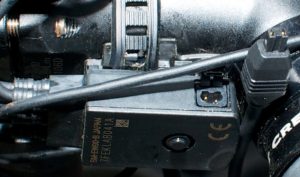
Hacking the SM-BCR2 to have a standard Di2 cable connector: If your 3-port or 5-port junction is inaccessible for charging, there is an alternative hack method to connect it to the system through a standard Di2 port. With basic soldering skills you can hack the BCR2 to be used with any setup. Buy any length EW-SD50 wire, cut off one end. Cut the wire on the output side of the BCR2. Splice the two wires together, so that the output wire of the BCR2 is now a standard Di2 connector. The charger has an inner (white) and outer (shield) wire; connect the inner white wire to the SD50 red wire; connect the charger outer shield wire to the SD50 black wire. You will then be able to plug the BCR2 into any Di2 port. Or use a SM-JC40 junction B and another length of EW-SD50 wire and go through the RD (by using the SM-JC40 to connect the rear derailleur, new output wire of the EW-SD50, and the wire that ordinarily connect the rest of the system to the rear derailleur.) Thanks to @Di2diy for the info.
SM-PCE1: This PC Configuration and Diagnostics adapter will not charge the internal battery. It offers the same configuration options as the SM-BCR2, but also add some advanced diagnostic and troubleshooting features that the SM-BCR2 does not have. It attaches to via the standard E-tube wire (just like the EW-SD50 cables) rather than to a dedicated port on the side of the front A junction.
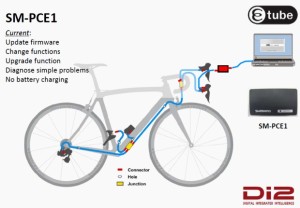
Bluetooth and E-tube Apps for Apple iOS and Android: Bluetooth wireless modules are available to allow system settings to be adjusted via the mobile applications that connect via Bluetooth Adapters.
Component Overview:
The confusing naming system used by Shimano makes it difficult to figure out what each component is, much less what it does and how it fits into an a complete Di2 system. Here’s an overview of all the major Ultegra and Dura-Ace Di2 components.
Dual Control Brake Levers/Shifters (a.k.a. Brifters):
ST-6770 Ultegra Road Dual Control Brake Levers/Shifters: The Ultegra version can be used with the climbing shifters. They are sold in in left/right pairs and are also available separately.
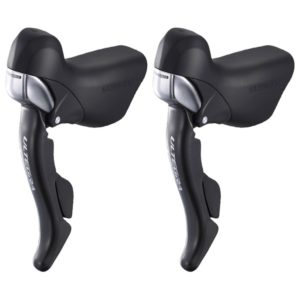
ST-9070 Dura-Ace Road Dual Control Brake Levers/Shifters: The main advantages these have over the ST-6770 version is slightly lighter weight and compatibility with the low-mount sprint shifters. As like the Ultegra version, they are compatible with the climbing shifters. They also have hidden button under the rubber hoods that can activate screen changes on cycling computers from Garmin, Magellan, Pioneer, and Shimano (Shimano SM-EWW01 ANT Wireless Broadcast Module required.)
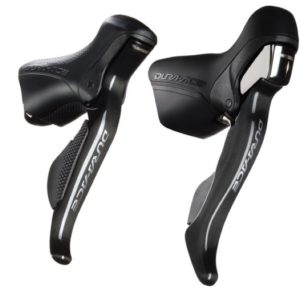
ST-9071 Dura-Ace Time Trial/Triathlon Dual Control Brake Levers/Shifters: These levers provide shifting from the pursuit bar position on time trial bikes. There is no Ultegra option offered at this time. These are available as left/right pairs, or can be ordered separately. These do have a permanently attached wire with a male end for connection the the SM-EW90 front “A” junction. Combined weight both levers: 117 grams.
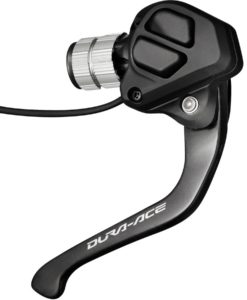
ST-R9160 (standard cable brakes) and ST-R9180 (hydraulic brakes) Time Trial Dual Control Brake Levels/Shifters: These are the lower-profile shifters offered with the newer Dura-Ace R9150 groupset.
ST-6871 Ultegra Time Trial/Triathlon Dual Control Brake Levers/Shifters: Ultegra version of the ST-9071 Dura-Ace shifters. Slightly heavier and much less expensive than the Dura-Ace version. Combined weight both levers: 142 grams.
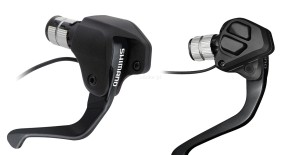
ST-R785 Hydraulic Road Dual Control Brake Levers/Shifters: These hydraulic road shifters are compatible with both the climbing and sprint shifters. These are compatible with the SM-RT99 centerlock 140mm and 160mm rotors and WH-RX31 wheelset (which as no standard rim brake track.) These require the BR-785 dual piston hydraulic disc calipers. They do not have the special wiring port required for the SW-R610 Sprint Shifters and a SM-EW90-B 5-port junction A is required to use the SW-R600 climbing shifter.
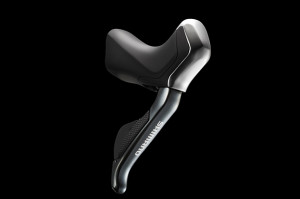
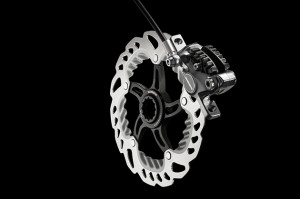
ST-6870 Ultegra Road Dual Control Brake Levers/Shifters: These road shifters are compatible with both the climbing and sprint shifters.
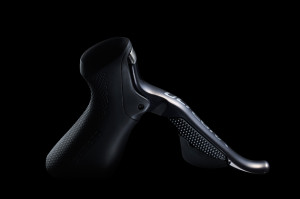
Dedicated Shifters:
SW-R671 Dura-Ace 2-Button Time Trial/Triathlon Bar End Shifters: These shifters are installed on the end of time trial aero bars. By default, the left shifter upshifts/downshifts the front derailleur; the right controls the rear derailleur. For both, the lower button upshifts into a harder gear and the upper button downshifts to an easier gear. This can be changed using the Shimano E-tube Project software; the functions of the left and right sifters can be switched with one another as well. These are available in pairs or separately.
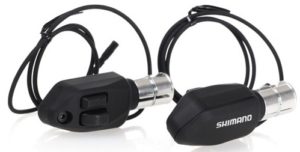
SW-9071 Dura-Ace 1-Button Time Trial/Triathlon Bar End Shifters: These shifters have only one button each and are intended to control only the rear derailleur, with one sending the upshift command and the other the downshift command. (I personally think this version is absolutely worthless. Why have 2 SW-9071 shifters at twice the price and twice the weight, when you can just buy a single SW-R671 Right shifter instead.)
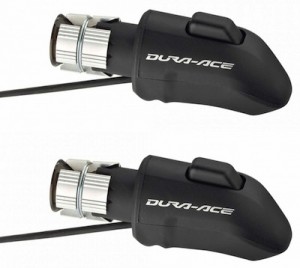
SW-R600 Climbing/PAVE Shifter: This shifter is for road bikes and is mounted on the upper horizontal portion of the handlebar, or any other location comfortable for the rider. They can be used in addition to the Dual Control Brake Lever/Shifter, or can be used on their own by plugging directly into a SM-EW90-A 3-Port Junction or SM-EW90-B Dura-Ace 5-Port Junction.
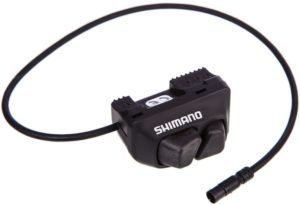
SW-R610 Dura-Ace Sprint Shifter: This is the only component using a unique wiring connector; it is only compatible with the ST-9070 Dura-Ace and Ultegra ST-6870 Road Dual Control Brake Levers/Shifters. Unlike all of the other shifters, the sprint shifters do not contain a circuit board; they do not show up as components on the CAN bus network. Instead, the sprint shifters are simple momentary switches that activate the circuit board on the host Dual Control Brake Lever/Shifter. The host dual control lever is what sends the shift command. (Note: Any momentary switch can be attached to the sprint shifter port on the Dual Control Levers by splicing into a standard EW-SD50 wire to act as remote shifters.)
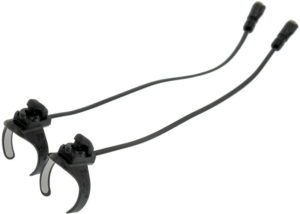
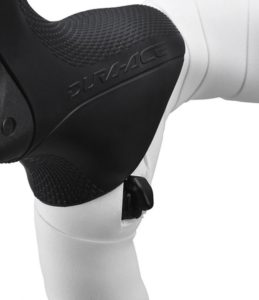
Alfine SW-S705 Right Flat-Bar Shifter: Reported to work with other non-Alfine setups.
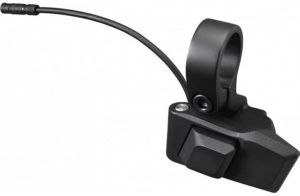
SW-R9160 Time Trial bar-end shifters (pair): These are-end shifters directly control the rear derailleur, with one for the upshfit and one for the downshift. The front derailleur is controlled automatically via automatic Synchronized Shifting. These shifters require the BT-DN110 Internal Battery for synchronized shifting.
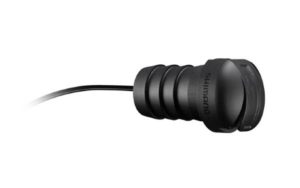
SW-R9150 Climbing shifters (pair): These tiny climbing shifters are about as small as the sprint shifters, but can be directly connected to a junction box and do not have to be connected as slave buttons to a brake/shift lever special port. They come with plastic mounts to make it easier to attach to bars beneath bar tape. They are ideal for synchronized shifting, with one controlling the upshifts and the other downshifts. These shifters require the BT-DN110 Internal Battery for synchronized shifting.
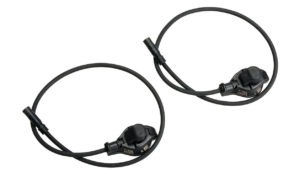

Front Derailleurs:
FD-6770: Ultegra Front Derailleur
FD-6870: Ultegra Front Derailleur, pretty much identical to the FD-6770 but with a slightly larger diameter adjusting screw (to better dissipate the shifting forces).
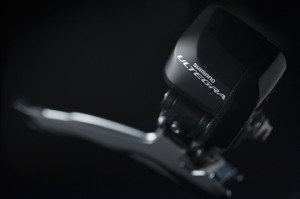
FD-9070: Dura-Ace Front Derailleur
FD-R9150: Dura-Ace Front Derailleur for 9150 systems; features slightly reduced weight vs. 9070.
Rear Derailleurs:
RD-6770: Ultegra 10-Speed Rear Derailleur, compatible with gears up to 28 teeth.
RD-6870: Ultegra 11-Speed Rear Derailleur, compatible with gears up to 32 teeth (for the GS version).
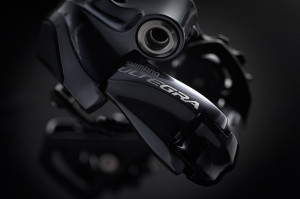
RD-9070: Dura-Ace 11-Speed Rear Derailleur, lighter weight version on which the RD-6870 is based.
RD-R9150: Dura-Ace 11-Speed Rear Derailleur with 30-tooth sprocket compatibility and modified “Shadow RD” geometry to keep the mechanism close to the rear wheel to help avoid damage in the event of an accident.
Alfine SG-S505 and SG-S705: The Shimano series targets comfort and urban bikes. It uses an 8-speed (505) or 11-speed (705) internal epicyclic rear hub. It is believed to be compatible with other Di2 ETube components but this has not been verified.
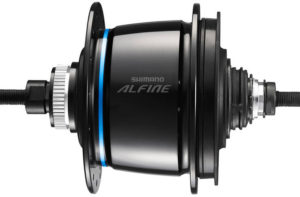
Display / Wireless Communication:
SM-EWW01 ANT Wireless Broadcast Module: This module wirelessly broadcasts Di2 data (front and rear gear selection details, gear ratio, battery life) to a cycling computer using the ANT protocol. It is compatible with Dura-Ace 9070, Ultegra 6870 Di2 and Ultegra 6770 E-tube road shifting systems. SM-EWW01 plugs into the E-tube wiring system between existing components. It has an 2 wiring ports, so it can be connected between a front shifter and the Front Junction A, or at the rear derailleur (between rear derailleur and Etube wire.) It transmits through a proprietary private ANT wireless protocol, which may eventually become a standard public ANT+ protocol. It is powered by the same Di2 system battery. It is currently compatible with the Garmin Edge 1000, Mio 505, and the PRO SCIO cycling computers (with more to come.) The hidden buttons under the hoods of the 9070 shifter levers will switch screens on the cycling computer when paired with this module. It does not currently allow for shifting control from a cycling computer/device and it is not clear that this functionality will ever be offered. The SM-EWW01 is 38mm long, 25mm wide, 12.5mm high, and weighs less than 5 grams. It does not come with any wires; 1 wire would have to be added if adding this module to an existing Di2 system.
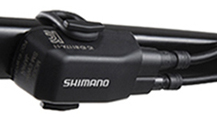
EW-WU101 and EW-WU111 ANT and Bluetooth Wireless Broadcast Modules: These modules are similar to the SM-WEE01 but also include Bluetooth capabilities in addition to ANT capabilities. They require the BT-DN110 battery or the BM-DN100 Battery Mount and cannot be used with the SM-EW67 Front A Junction.
SC705 Alfine Display Unit: This unit displays the battery level and the rear derailleur gear selection. It is powered by the system battery and has a port for the SM-BCR2 internal battery charger / USB diagnostic tool. It is primarily designed for Alfine systems (both 8 505-series and 11 speed 705-series). It is compatible with Ultegra and Dura-Ace Di2.
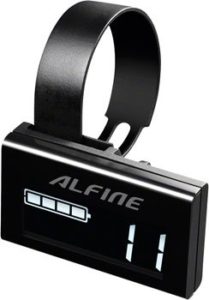
MT800 Digital Display with Bluetooth: Primarily aimed at XT mountain bike applications, this display allows toggling between the 3 synchronized shift modes (where both derailleurs are intelligently coordinated in unison by one pair of buttons, so no need for discrete shifting of the front derailleur.) It also shows battery level, gear position, shift mode and FOX iRD suspension position. The Digital Display required the new BT-DN110 battery. Existing Di2 XT systems are upgradable to be compatible with the new digital display after battery upgrade and firmware upgrade. This display has 3-port Di2 Cable junction and charging port integrated into the back and serves as a Front A Junction.
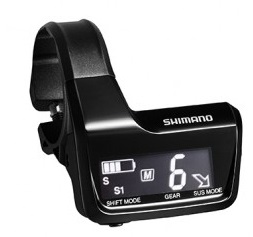
Batteries and Battery Mounts:
The batteries contain the main controllers for the system. It is therefore required to upgrade the battery to get features released in new versions of Di2 (such as Synchronized Shifting that automatically controls the front derailleur based on rear derailleur shifting.)
SM-BTR1 External Battery: This external battery must be used with the SM-BMR1 battery mount. It is removed from the mount and charged using a dedicated charger.
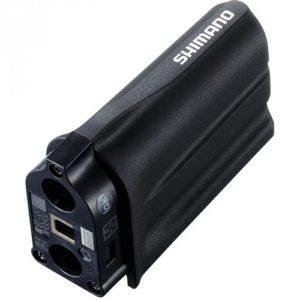
SM-BMR1 and SM-BMR2 External Battery Mount: This mount attached to bottle cage mount points or other dedicated frame mounts. It is available in 3 different mount lengths: -I (intermediate length), -S (short length), -L (long length). The SM-BMR2 is an updated version of the SM-BMR1.
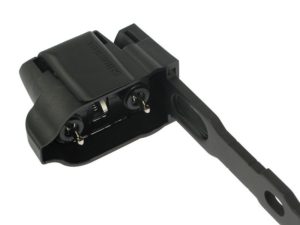
SM-BTR2 Internal Battery: This battery is typically mounted in the seat post or seat tube of the frame. It is charged by plugging the SM-BCR2 Charging Cable/PC Adapter into the SM-EW90-A or SM-EW90-B Front A junctions.
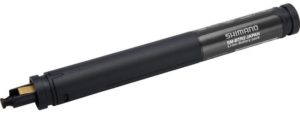
BT-DN110 Internal Battery: This battery is required for Bluetooth wireless units and road groupset Synchronized Shifting functionality.
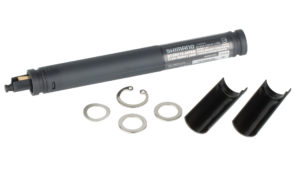
BM-DN100 External Battery Mount: This battery is required for Bluetooth wireless units and road groupset Synchronized Shifting functionality.
Front A Junctions:
SM-EW67-A-E Ultegra 3-Cable Junction: This is the original front junction with 2 integrated cables to connect to the dual control brake lever/shifters. The male cable ends on this Front A Junction will not mate directly to the male cable ends on any of the Time Trial/Triathlon dual control brake shift levers or shifters; SM-JC41 Rear B Junctions can be used to connect this front A junction to TT/Triathlon shifters. This Junction works only with External Batteries, not Internal Batteries.
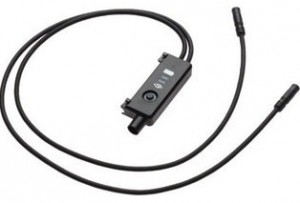
SM-EW90-A Dura-Ace 3-Port Junction: This front “A” junction is most commonly used in road bike setups. 2 ports connect to the dual control brake / shift levers; the third port is for the cable that leads to the bottom bracket junction.
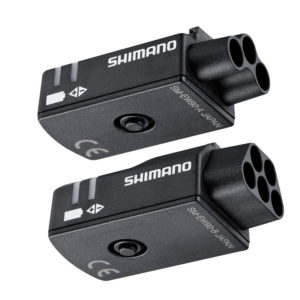

SM-EW90-B Dura-Ace 5-Port Junction: This front “A” junction is primarily used in the Time Trial / Triathlon setups. 2 of the port are for the brake/shifter dual control levers, 2 of the ports are for the aer0 bar bar-end shifters, and the 5th port is for the cable that runs to the bottom bracket (where the B junction joins the wires from the front A junction, front derailleur, rear derailleur, and battery.)
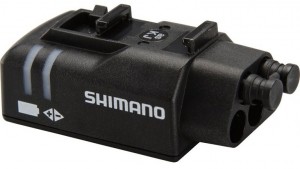
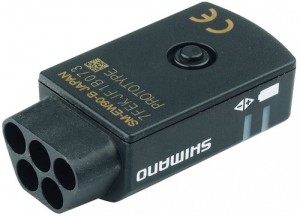
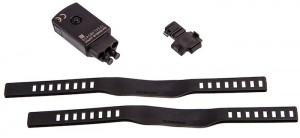
EW-RS910 Internal Bar-end Junction: This junction is installed into the end of a bar or in a dedicated frame port. It facilitates internal cable routing.
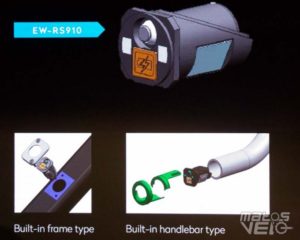
B Junctions:
SM-JC41 Internal Junction: This version has the exact functionality as the SM-JC40 external version, but doesn’t have the mounting tab for being bolted to the bottom bracket or wrapping the extra cable lengths. It has 2 ports on one end and 2 on the other, making it more compact. In addition to being located at the bottom bracket to connect the A junction, battery, front derailleur, and rear derailleur, it can be used at the handle bars to join multiple shifters prior to being connected to the A Junction.
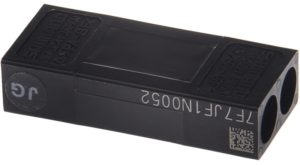
SM-JC40 External Junction: This version is intended to be attached to the frame using the bolt that is commonly located underneath the bottom bracket housing. This junction contains no electronics; it’s sole purpose is to join 4 connectors together, which are usually the wire from the front A junction, the battery, the front derailleur, and the rear derailleur. There are wire holders above the housing to capture the extra wire length by wrapping it back-and-forth.
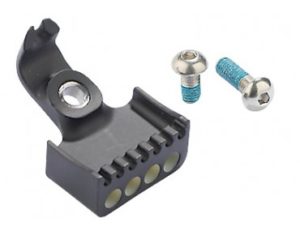
Cables, Grommets, and Cable Remove/Install Tool:
EW-SD50 Cables: These cables connect the front A junction, the battery, the front derailleur, and the rear derailleur to the rear B junction, which is typically located near the bottom bracket (near the cranks.) These are available in lengths of 300mm, 350mm, 400mm, 500mm, 550mm, 600mm, 700mm, 750mm, 950mm, 1000mm, 1200mm, 1400mm.
SM-GM01 Grommet: These round grommets are used when drilling round holes for internal cable routing, or with existing round holes. The required hole diameter is 6mm (6mm = .236 inches. Use a 7/32-inch drill bit and then “wallow-out” the hole to make it a little bigger; a 1/4-inch drill bit will work but is just slightly larger than necessary.)
SM-GM02 Grommet: These 7mm x 8mm oval shape grommets are used in some situations / frame designs.
Shimano TL-EW02 Ultegra DI2 E-Tube Tool: This tool is used to connect and disconnect the Etube wires. They are extremely difficult to connect/disconnect by hand, and pliers or other tools can damage the wires. Don’t get this confused with the TL-EW01 tool, which is for the older 5-wire 7970 cables. (My Dura-Ace TT Dual Control Levers came with one of these tools, but no other components did.)
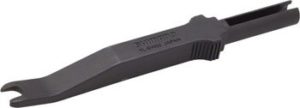
Common Questions (via Shimano):
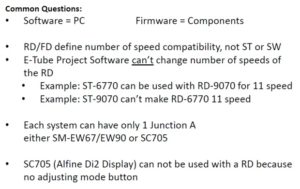
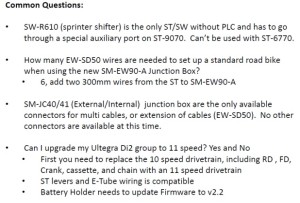
Note: it is not necessary to replace the FD from upgrading from 10-speed to 11-speed.
What Components do I need to put together my own Di2 system?
Because of the huge number and variety of components, it’s very difficult to figure out what is actually necessary and what is optional. So here is a list, for the setup I recommend: Ultegra 6870. It starts from the handlebars and works backwards. (This assumes both front and rear derailleurs, but you actually don’t have to have both; you can pick one or the other and only the corresponding front shifter to go along with it.)
- Any Type of Shifters / Shift Buttons. The Dual Control Brake Levers/Shifters are not required. You can get the just the climbing shifters or Triathlon/TT bar-end shifters, and then potentially add the Dual Control Levers/Shifters at a later point. (The only exception is the Sprint shifters, which require specific Dual Control Levers/Shifters with special ports as noted elsewhere in this article.) Amazon.com link
- EW-SD50 Wires 1 and 2 between the front shifters and the Front Junction A (0nly for some shifters). This is a bit confusing, because some of the front shifters come with wiring attached to them and some of them require purchasing separate wires. In general, most of the stand-alone shifters come with wiring, as do the TT/Triathlon dual control shifters/levers, but the road dual control levers do not. Amazon.com link
- Front Junction A. I recommend the SM-EW90-B 5-port front junction A as it provides the most upgrade flexibility; get the 3-port option only if you’re positive you’re never going to add more shifting components. The older SM-EW67-A-E has 2 wires built-in to connect with each of the dual control shift/brake levers; it doesn’t offer much flexibility or compatibility with a TT/Triathlon setup or adding additional shifters. Amazon.com link
- EW-SD50 Wire 3 between the Front Junction A and the 4-port Rear Junction B connector. Amazon.com link
- EW-SD50 Wire 4 between the Rear Junction B and the Front Derailleur. Amazon.com link
- EW-SD50 Wire 5 between the Rear Junction B and the Battery. Amazon.com link
- EW-SD50 Wire 6 between the Rear Junction B and the Rear Derailleur. Amazon.com link
- Rear Junction B: This is where the wire from the front of the bike is connected to 3 output wires leading to the front derailleur, rear derailleur, and battery. SM-JC40 is for external wiring, SM-JC41 is for internal. Amazon.com link
- Grommets for any place where the wire goes into the frame through a drilled hole. Amazon.com link
- Front Derailleur. I recommend the Ultegra FD-6870 for 11-speed builds or the FD-6770 for 10-speed builds. The Dura-Ace FD-9070 is pretty much identical, just slightly (41g) lighter and 11-speed only. (I do not recommend the Ultegra FD-6770 unless you have a 10-speed setup, because of firmware compatibility issues with 11-speed rear derailleurs. Also, it is an older design than the FD-6870, so it is larger and offers slightly less shifting force.) Amazon.com link
- Battery and Charger. Internal or external, depending on the build. If you have to skill/time/money-to-pay-someone to get everything internal, I highly recommend that option. The SM-BTR2 internal battery has more advanced integrated electronics and is better for firmware upgrades with the SM-BCR2 internal battery charger/PC tool. If you go with the SM-BTR1 external battery, you will need the SM-BMR1 external battery mount and SM-BCR1 external battery charger. Amazon.com link
- Rear Derailleur. I recommend the Ultegra RD-6870 for a new build if you have 11-speed compatible wheels with 11-speed sprockets, or the Ultegra RD-6770 if you have 10-speed wheels/sprockets. The system must be match front and rear derailleurs (both 6870 11-speed or both 6770 10-speed.) Amazon.com link
- TL-EW02 Etube Wire Remove/Install Tool: It takes quite a bit of force to snap the wires in/out. You may think you can get it seated properly with just your fingers, only to then have the wire come loose because it wasn’t fully seated. It’s a good idea to keep one in your saddle bag. Amazon.com link
What wire lengths do I need? This question is impossible to answer correctly, as it’s highly dependent on the frame size and configuration. What I recommend is running string between the component mounting locations to measure the lengths. Be sure to add some extra length, as I find that wires seem to come up short pretty frequently, even when “adding a little extra” to start with. Nothing is more frustrating that having a wire that is 25mm too short. I recommend ordering a few extra wires of multiple lengths and then returning the unneeded/unused wires. As noted above, the standard wire lengths are 300mm, 350mm, 400mm, 500mm, 550mm, 600mm, 700mm, 750mm, 950mm, 1000mm, 1200mm, 1400mm. Do not cut/splice these wires; the connectors on the end of the wires are very small in diameter to start with and you’ll end up with a splice that is larger and less waterproof than you started with.
Acknowledgements: Special thanks to Di2diy for his continued help in the comments. Check out his Ebay store for custom Di2 batteries, harnesses, and components.
Technical Details of the Di2 CANBUS protocol and signaling
Thanks to commenter Ghislain for the details: “I reversed engineered the signal going to the RD. Since I did not have a special tap connector, I could only look at the actual signals in open loop (RD wire disconnected) on the wire going to the RD using an oscilloscope. First, I found that shift up and down are multiplexed on the same wire. A shift down would generate a positive 100 msec clean 8 volt pulse (varies between 50 msec to 500 msec depending on how long you hold the shifter). On the same wire, a shift up would generate a series of 2 msec pulses that would last the same time of a shift down pulse. Therefore, the RD has enough intelligence to discriminate between the 2 types of pulses. When you hold the button on junction A, a 140 msec pulse is generated. But since my RD wire was disconnected, the RD would not go in adjust mode.”
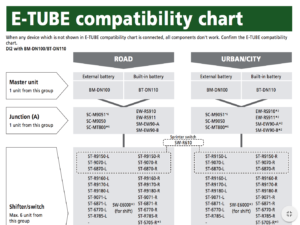
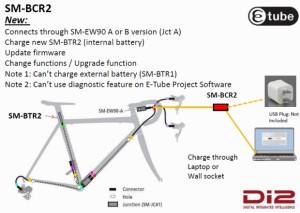
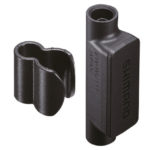
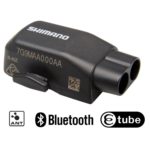
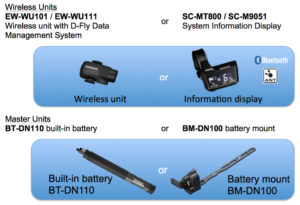
Hey team… I’m hoping someone on here may be able to point me in the right direction with an issue I’m having with my EW-WU111 BT module.
I recently changed out my phone and now my E-Tube app is asking for my 6 digit pass key (pin code). For the life of me, I can’t remember what I set it to. I’ve tried the default 000000 and every other code I would usually think of using to no avail.
Is it possible to reset the code back to default (i.e. factory reset)? Or any other tips?
Thanks heaps in advance!
You’ll need to use the PC-based e-tube software and the USB wired connection.
Thanks Carlton… I had a sneaking suspicion that may be the case.
You’ll need to connect using the Windows version of E-tube and the USB wired connection.
Hi, I am using an RD6870 rear derailler and a 12-25 cassette. When the chain is on the large front chainring(50) shifting up from 21 to 23 all works well. When I want to shift back from 23 to 21 i have to press the shifter 2 times and after that the chain goes from 23 to 19. When i have the chain on the small front chainring all seems to work well. What could’t be the problem?
If the setup is old and used to work, check the upper jockey pulley for wear. Pointy teeth are bad. I just fixed that on an 8k mile setup. Otherwise do some rear derailleur shift point tuning.
I would agree with Wilson that your jockey when and its bearings may be a little worn. I would also suggest that you carry out the fine tuning of the rear mech.
Thanks for the tips.I will check the jockey wheels and replace them if necassery.
I’ve ran into vague shifting on one or two gears when the drop out hanger is out of alignment.
To a first-order analysis, picking the center between the edge setting where all shifts to the next larger cog work and the edge setting of where all shifts to the next smaller cog work should be good enough. And those two edge settings are found shifting individually across the full cassette on both chainrings. Eyeball centering of the chain and pulley under the cog may yield better chain life and lower drag than my method, but I do not know.
In more detail, when fine tuning, for each rear cog there should be a range of settings where it both upshifts and downshifts. That range may not be the same for different cogs, and also may not be the same for a given cog with each chainring. And for the truly anal, it may not be the same on even tooth cogs depending on how the narrow/wide links of the chain sit on each tooth, as the teeth are different on that cog and adjacent cogs. And yes all this matters for those of us who use our own cogsets instead of cassettes.
just got a problem cant see left shifter in etube and also not working front derailleur.
I’m having an issue adjusting the RD 9150 on my “new” SL5 S Works bike. The Di2 system won’t change onto the 11 (smallest ) sprocket. The high gear stop is well out and using e project set up it shows in the customising section that the derailleur is on the 11 sprocket, which its not. The same feature occurs at the low end of the cassette, when the chain is on the largest sprocket, eproject shows its on the 2 sprocket. It’s as if the whole cassette cage needs moving outwards. The 9150 has the hanger link which can be removed but that in theory at least will move the cage inwards. Additionally I doubt if there’s enough clearance on the inside of the frame to do this. Any thoughts?
If you have the chain on the small front ring, it won’t go to the 12 or 11 sprocket anyway. You will only get the full 11 sprockets when using the big ring.
As for the issue of the chain not going to the largest sprocket, this sounds like your fine tuning is completely to one side of its 30-odd increments.
Follow th instructions on fine tuning, but press the button 40 times in one direction to ensure that you are really to one side . The. 20 clicks in the other direction.you should not be pretty close to centre,
Click in one direction until you start to hear or feel the chain rubbing on the next sprocket. Then count the number of clicks in the other direction (e.g.12) until you get noise/feel in that direction. Now go 1/2 that number of clicks back.
Hopefully, the fine tuning is now spot on.
Reset your mechanical end stops. Should all be good now.
Hi Stephen, thanks for taking the time to reply. On the firdt point I do have the chain on the big ring when on the 11 sprocket. The odd thing is that using the eproject RD adjustment system the gear shown is 10 not 11. And this error is repeated all the way through so that on the largest sprocket it shows that its sprocket 2, not 1. Using the fine adjustment that Shimano describe doesnt really help becase to get the chain onto the correct sprocket is at the end range of the 16 steps available and the chain is totally out of alignment. Bit of a puzzle this, my other bike with Di2 is perfect and as far as `i can tell the set up is identical.
I’m assuming that you’ve set the mechanical limit screws on the derailleur to their limits and that’s not the problem.
Most likely you have an issue with sprocket/hub/frame spacing. The sprocket needs to move relative to the hub. I think you need a spacer to move the sprocket outwards, but not positive. Or perhaps an adjustment to your derailleur hanger.
We Stephen you wer partly right: I found the rear derailleur had not be correctly clamped with he link to the drop out not hard against the stop, if that make sense. I loosened the company and rotate he mech further around in an anti clockwise direction;that improv the gear selection quite a lt but not the missing cog.
I gave upon hat but one o he consequences was th chain running on th largest sprocket and the large chaining. The solution to this was to alter the synchro shift map to blank out the No 2 sprocket. Now when changing down, because of the “missing” cog the shift goes to the small chaining and the No 4 sprocket from the N2 . I poet hat clear!! I’m quite happy now, the fact I can’t get onto the 11 sprocket is no big deal. But I’d till like to know how to know go to find it. My other Di2 bike, with exactly the me settings has all th cogs available. Again thanks for your comments. Regards, Davd
hi there
i andreas from indonesia
i planing to upgrade my groupset to di2
but i want a completely different setup to safe some money
rd 6870
fd 6870
junction b
junction a
internal batt
and for the shifter i likely want to do some DIY
i planing to use bullhorn handlebar and aero bar
brake lever is tt lever
mechanism tipe
and for the shifter
can i go from diy? and without the dual control lever?
You cannot go DIY on the shifters. They are not simple push button switches. The shifter buttons contain electronics/micro-controllers that send coded messages over the wires to the other components. You must use Shimano di2 shifters that contain the required electronics.
You must use Shimano switches, but you CAN do a low cost DI2 install and build up as and when you have the money.
Since you wish to use Bull-Horn bars, only the TT-style brake shifters would be suitable, and these are expensive (even on Ebay).
1:/ Consider controlling the REAR mech only. (Run a single ring at the front, or use a manual mech).
2:/ Use a SW-600 climbing shifter. This can be attached to the bars with a cable tie.
2a:/ If you are using TT extensions, you can use TT bar end shifters
3:/ Buy either the DN-100 battery mount (external fit battery) or DN-110 battery (this will save you buying one next year)
4:/ Make sure to buy the 5-port junction.
5:/ Think about where you can hide the battery and 5-port. (I use a small bento bag on the top tube )
6:/ Use LONG cables direct from the 5-port to the mech. (This is more reliable and saves the need to buy & hide a JC-41 junction, and reduces the number of cables )
5:/ If you want to control a DI2 front mech, you can do this by….
i:/ Use SYNCHRO and control both mechs with the one switch
ii:/ Buy a second SW-600 switch
iii:/ Buy Di2 TT brake levers when you can afford them.
https://flic.kr/p/2fJVXF7
Hi
Did notice a drain of the battery, after some tracing I located it to left shiffter and a leak-current of 2 mA so the drain problem was found.
Have you seen something lika this? (and what can it be then, I didn’t have any Torx #5 home so I couldn’t take it appart)
Is there anywhere to get hold of just the electronic in the shiffter?
Before asking, yes all FW are up to date
BReg
Johan
Greetings,
i was wondering if i could take the Ultegra Di2 6780 from my spare bike and build it up by adding new hydraulic shifters to work on a Di2 disc frameset? I feel like i am missing something…
This is the latest compatibility cart from Shimano. It tells you what works together.
http://e-tubeproject.shimano.com/pdf/en/HM-CC.3.4.3-00-EN.pdf
Question :
I have a 10 speeds Ultegra 6770 groupset on on Time trial bike, may it be possible to have DR 8050 derailleur in order to have 11 speeds (with a firmware version X.XX ?
Or the only possibility to get 11 speeds with de 6770 groupset is to get RD-6870, or RD 9070 (with a FIRMWARE INSTALLED FROM E-TUBE SOFTWARE VERSION 2.5.2 OR EARLIER) ?
Any suggestion ?
I never update my firmware on my TT bike (6770 groupset) since I bought in 2013
I don’t know for certain, but my guess is that the Ultegra 8050 is too new to work with your original firmware. The battery firmware would not recognize it.
Your best option is to upgrade both the front and rear derailleur at the same time. The second best option would be a 6870 rear derailleur and no firmware update.
Thanks, if I bought a Brand New one RD-6780 rear derailleur in a store (i Found some places) do you know witch firmware version is on it. Does It depends when Shimano produced it or by default they install the oldiest ?
It’s hard to say which version of firmware will be installed. But it will most likely work without having to do anything. Worst case, you’ll need to update to the “last compatible” firmware version.
Hi
I have the full set / group Ultegra DI2 6870 – My rear derailleur got smashed when my gear drop broke and the shifter went into the wheel. My question is: Can I mix the group?`- I saw the new DI2 8050 Rear derailleur – Can I use this in my setup? or should I just stay with the 6870 components?
Thanks
I also want to add the EW-WU111 unit – to upgrade the system while I am at it!! 🙂
Netzie
Denmark
The latest compatibility guide is posted in the comment above: https://carltonbale.com/shimano-di2-everything-you-need-to-know/comment-page-18/#comment-135517
You’ll likely need to replace your battery with the new version if you switch to an EW-WU111. Details are in the article above.
do you have a printer friendly version of this post or a PDF i could get from you?
Hello, I am a French user of Shimano Ultegra di2. Thanks for your page on di2, very useful! Please, could you tell me if I can charge my di2 battery (internal) with a mains USB charger. The seller of my bike told me that it is impossible and dangerous. I cannot understand why. The only difference between a mains USB charger (5V) and a laptop usb port is the amperage. I imagine that if the amperage is too low, it will not work. But if I use a mains USB charger (5V) with 2 A, for instance, I cannot understand where is the problem. It is more convenient to use such a charger than to go in my garage with the laptop. Thank you for your reply, best regards . Serge (France)
I have been using an Apple iPhone USB charger for the past 6 years with no issues. It charges at 5 volts and 1 amp max. Any charger should be fine – the current output should be dependent on the device connected, not on the charger itself. If you want to be extra careful, use a small 1-amp mobile phone charger. But any USB charger should be fine.
Many thanks for your quick and accurate answer. It’s more convenient to charge with a mains USB charger!
I do not know why many sellers (at least in France) say that you have to charge only from a laptop. It’s an instruction that probably corresponds to a time when phone chargers were not powerful enough.
Thanks for the great write-up. What battery is required to get Synchronized Shifting to work with the 6770 series? For an internal battery, will it work with the SM-BTR2, or does it absolutely require the new SM-DN110?
Unfortunately, 6770 only supports multi-shift of the rear derailleur. It cannot be upgraded to syncro-shift between front and rear derailleurs.
hi, very useful info, can you help me with my query , I have a bike with the original install of ultegra 6770, with the addition of remote shifter button on the bars, I would like to know what is the minimum upgrade needed to give me synchro shift using these buttons on the bars
You’ll need to upgrade the front derailleur, rear derailleur, and battery to get multishift. And upgrade the firmware on all other remaining components. You’ll need at least Ultegra 6870 or newer derailleurs. This also means you’ll have to upgrade to an 11-speed cassette at your rear wheel, which may require a new wheel.
I have a related query. I also have the 6770 setup and I would like to replace the rear derailleur which is pretty scarce. If I go with a 6780 rd with upgraded chain and cassette leaving everything else intact, what software upgrade would I have to make to have everything work, I.e.-using all the other 6770 components?
Carlton,
I was wondering about the SW-R9150 Climbing shifters.
I just upgraded to Hydraulic 9150 Di2 and see only 2 ports per STI lever.
My previous Di2 the 9070 I had rim brakes and the sw-R610 sprint shifters, which
I did the splice wire hack & had 2 of the sprint shifters on each side. One on the top for climbing & also on the drops for sprinting.
Is this same hack able to be done with the new 9150 climbing shifters?
If not, is there any way you might know of to still achieve this to get buttons in both places?
I really like having the option of having the shift buttons on the top & the drops.
Thanks so much fo rate excellent write up you did on the Di2
Rob
Your R9170 levers should already have a remote button on top of the hood. I would presume that within the E-Tube APP, you would be able to program this button to do gear changes.
You then only need 2 ports, one to connect to the junction, and the other free for connecting to an R600 switch.
Of course you can use JC-41 junctions to provide more ports and connect many more switches to your handlebars !!
I have Dura-Ace Di2, installed the wireless module, updated all firmware , and have connected to my Garmin Edge 1000. Everything is recognized. Neither the right or left hood switches are working. The Garmin Edge is displaying the battery level, gears etc so I know there is a connection. I’d like to use the hood switches to change the Garmin screens and the potential other functions. Suggestions would be appreciated. Cheer, Mike
Did you configure the buttons for Garmin control in eTube? I don’t have this hardware setup, so I’m not sure if that is required.
Yes. I am configured in etube. Is there a hardware fix / check to make sure the hood buttons are working?
Not to my knowledge, but I’ve never worked with that setup, so I can’t say for certain. Sorry I couldn’t be of more help.
Have you also configured your Garmin? As far as I know the EW-WU111 Wireless modules can send different signals (on 4 channels). You need to tell your Garmin what to do for each button.
I configured the d_fly software and configured it on the garmin. I even replaced the d-fly ew-wu111 in-line unit. All firmware is up to date. The garmin receives info but won’t send commands such as next-page or lap start/stop
Solved! I did a factory reset of the Garmin and all works now. Thx all!
The Garmin 1000 is a few years old. There is certainly mention of Di2 Sensors in a few of the older firmware updates. I would therefore suggest you check which firmware you are currently running (there should be a System “About” page on the screen). Current firmware is 15.20
https://www8.garmin.com/support/download_details.jsp?id=6735
Hi Carlton, thanks for all your work. We would like to use Di2 for a junior racing setup where the gear ratio is restricted. Is there a method for disabling the front shifter, leaving it in the small chainring only? Thanks.
I wonder if you unplugged it during set up using E tube then the SW would recognise its absence and maybe not try talk to it. You would loose a key feature though, that of the front mech auto trimming.
Unplugging the wire to the front derailleur will definitely prevent front front shifting. It will function like a 1x setup; a front derailleur isn’t required in a Di2 setup.
If you do block the large chainring suggest talking to USA Cycling to verify legality. I know adjusting the high limit on the rear derailleur to block cogs is not allowed. I suspect blocking the big ring may be viewed in a similar manner.
Hi Carlton, Hopefully you can help me. I have full Ultegra R8050 groupset with D-Fly. Groupset has been running fine until this week. Now to change gears (front or rear) requires two taps to the lever. It appears the first tap wakes the system and the second tap changes the gears. The same applies to buttons on the hoods to change the screen on my Garmin 820. I have logged into E-Tube App and all firmware is current and everything looks fine – no errors. Thanks in advance for any assistance.
I haven’t heard of this being a persistent problem. I’ve noticed this happening after the bike is unused for a while, but only after a long timeout period. What’s your battery level and do the indicator lights on the Junction A give any indication of a problem?
Thanks Carlton for your quick response. I have completed an error check of each component via the E-Tube App. No error found and each component fully functional. Initially I though this was a low battery issue so I fully charged the battery (seat tube version) but no change. The junction box shows no indication of an issue. I rode the bike again today after the E-Tube App full analysis last night and the issue still persists with every gear change from start to completion of the ride. One thing, the issue disappeared while the battery was being charged (via junction box to iMac usb). Based on this I am thinking it maybe a battery issue. I plan to take the bike to my local bike shop to hook it up to the PC tool rather than E-Tube App for analysis. Any thoughts?
Hard to fine tune big/small shifting on R8070 di2
Problems with shifting big/small on R8070…I built a bike during the summer and it is a Sworks Roubaix 2019 model. Fitted it with R8070. 50/34 crankset , 11/30 cassette and a RD-R8050-SS. My distance from center of crank to rear axle is 418mm and I put on a chain 110 links which is two links longer than recommended. I did this as on big/big, the cage was tight. I had to screw the B nut back as the chain was loose when on small/small(3rd smallest sprocket). Just last week I noticed, that when on big chain ring, when going from the big sprocket to the small one it took some time to get onto the 11 tooth and back up out of it. I then removed the two links to bring it to 108 links(54 inches) and it is still the same. The RD moves OK, but looking, it seems the guide jockey wheel seems close to the crakset( about 35mm forward of the 11T) I think that the RD moves, but the guide wheel is so far away from it, it is not pushing the chain close enough to the 12T to mount up on it. Have you any ideas?
I tend to follow Shimano’s or Park Tool’s guides on sizing my chain. Have a look at https://si.shimano.com and enter rd-rx8070 in the search box. Then open the “DM” (dealer manual) PDF file and have a look at their instructions. Note that their instructions vary depending on the largest sprocket you have.
For the Park tool instructions, have a look at https://www.parktool.com/blog/repair-help/chain-length-sizing
so ive had my sm btr2 battery about 3 years,due to the amount of time it took me to gather my parts and build my bike ive only used it for 2 summers and charged the battery 4 times,now everytime I come to the bike the battery is dead,ive charged it and removed it from the bike,tested on a multimeter and it reads 3.2v surely it should read 7.4v on a full charge,even left off the bike the charge is diminishing day by day so it cant be a wiring issue on bike,surely it should have lasted longer than 4 charges and 2 summers and at £110 to replace is a bit of a kicker,ive now opened the battery and sourced two 14430 replacement batterys at £12 and was wondering if anybody has actually replaced the rechargeable batteries inside and had no issues as the firmware is stored in the electronics inside battery casing
Try recharging them with the usb port on your PC. I had a problem where the battery was not holding charge, and this sorted it out.( that was 22 months ago). The same problem came back about 10 months ago. Traced problem to my RD-6870-gs( it was drawing 2mA all the time) changed it and all still ok……………. Changed two batteries for friends and both showed up different problems, Took the two units apart and swapped the battiers. One hasnow the two problems and the other one is ok. Carried out a off load voltage test for three weeks, measuring the voltage at 6am and 6pm. All ok. Remember the battery unit has a master control unit in it as well. With the new battery unit you will get some new shifting options as well. I can outline the problems in detail if required.
Hi ive charged from laptop and from an ipad wall charger, I’m too using the Rd 6870 but as battery is still discharging off bike I assume its not Rd, if you wouldn’t mind outlining problems in detail that might help. Also so replacing the actual rechargeable batteries is an option then with the 14430s I’ve found online
Oh and what voltage does an off load di2 battery read
Battery Issues, Sept 2019. Mary and Tom SM-BTR2
Mary’s battery (Focus Cayo) will not charge. It shows up a flashing orange led on the left symbol. SM-PCE1 shows up no fault.
Tom’s battery ( Canyon) will charge and on the Fluke DMM, shows up 6.8volts. When testing the battery capacity with the SM-EW90-A, it is flashing red. If you try to change any gear, nothing happens. When plugged into SM-SM1, it shows up a message “Fault may be present”.
On 28th September2019, I decided to swap around both battery sets to see if I could get one unit working (a little bit of soldering).
Mary’s unit (with Tom’s two batteries) seems to be ok on charging and when connected to the SM-PC1.
Tom’s unit, Flashes red on the right led on the charging unit. When tested with the SM-PC1, it showed up with a fault.
Summary,
Mary’s master unit is ok, just her batteries are damaged. Tom’s batteries are ok but he had a problem with his master unit.
See the excel sheet in this file that has testing done in Oct 2019. I deem this battery to be ok and to return to spar
29/09/2019 11:30:00 7.89
29/09/2019 18:30:00 7.88
29/09/2019 21:00:00 7.88
30/09/2019 06:30:00 7.87
30/09/2019 18:30:00 7.87
01/10/2019 06:30:00 7.87
01/10/2019 19:00:00 7.87
01/10/2019 23:30:00 7.86
02/10/2019 06:30:00 7.86
02/10/2019 19:00:00 7.86
03/10/2019 06:30:00 7.85
03/10/2019 20:30:00 7.85
04/10/2019 06:30:00 7.85
04/10/2019 19:00:00 7.85
05/10/2019 11:00:00 7.85
05/10/2019 19:00:00 7.85
06/10/2019 15:00:00 7.85
07/10/2019 16:00:00 7.85
08/10/2019 19:00:00 7.84
09/10/2019 18:00:00 7.84
10/10/2019 18:00:00 7.83
11/10/2019 20:00:00 7.83
12/10/2019 18:00:00 7.83
13/10/2019 12:00:00 7.82
14/10/2019 21:00:00 7.82
15/10/2019 19:00:00 7.82
16/10/2019 21:00:00 7.82
17/10/2019 21:30:00 7.81
18/10/2019 06:30:00 7.81
19/10/2019 11:00:00 7.81
20/10/2019 19:00:00 7.81
21/10/2019 20:00:00 7.8
22/10/2019 20:00:00 7.8
24/10/2019 20:00:00 7.8
25/10/2019 20:00:00 7.79
Date Time Voltage.
See above data taken from a battery unit left disconnected for the duration of the test. DMM was only connected when a reading was taken.
Thx mine is reading 3.27 fully charged day 1,day 2 2.12v. Day 3. 1.27v will de solder internal battery and test each one individually
Solder in the new batteries. Let me know where you got them, I was looking for them, but they were too expensive compared to a new battery unit.
traveling across country with bike, in a bike bag, in the back of a loaded car. Is there a way to shut off the battery so that I can avoid the possibility of the shifters continually shifting if something moves and leans against them during the trip?
Unplug the di2 cables from the shifters to the junction box, at the junction box during travel
Bought batteries off ebay £5.99 each just type in 14430 battery, seems to be working for now, so sorted for just £12
Hi, I’m looking at upgrading a Ribble Aero TT 10 speed bike I just got 2nd hand to Di2. It may be a 2015-2017 model and not Di2 compatible, so the battery & wires would all have to be external.
I’m trying to way up the extra cost and hassle of converting the bike to 11 speed in order to get Di2 synchronized shifting, rather than just getting a FD-6770 & RD-6770.
For the time trial bar-end shifters & climbing shifters, it’s noted that these shifters require the BT-DN110 Internal Battery for synchronized shifting. What about using the BM-DN100 external battery mount, that was listed as enabling synchronized shifting or are they slightly different?
I could possibly mount an BT-DN110 Internal Battery inside the aero seat post, but I didn’t like the idea of drilling a hole in the carbon frame to get the wire out to connect it to the rest of the setup.
Great article, very detailed, thanks
I haven’t used the external battery, so I can’t tell for sure. Check out the e-tube compatibility guide.
https://e-tubeproject.shimano.com/pdf/en/HM-CC.3.4.3-00-EN.pdf
It appears that the external battery/mount BM-DN100 are compatible with syncro shift. Or the Built-in battery BT-DN110.
Hi I have update a 6770 bike. You have to update the battery to BT-DN110 and the front Derailleur to 6780 as well as the rear Derailleur to 6780 as a minimum. Sure there is a way to avoid updating and he FD but it’s way past it “end by date”. You’re best to update both. You can still use the same brakes they work fine. The only think you miss is the buttons on the top which most people use to adjust their bike computer.
By the way, I retrofitted my 2007 Cervelo P2c with internal Di2. Drilling holes in carbon isn’t that big of a deal. Just make sure you use new, sharp drill bits. Start each hole with a tiny drill bit and work your up to the desired hole diameter one bit at a time. Keep all holes at least 1 tube diameter away from joints between tubes (i.e. the wire entering the top front of the top tube should be at least a couple of inches away from the steer tube.)
And always the wear a dust mask
You really do not need to drill a frame. The Di2 cables are so easy to cut and re-solder, so you just need a hole big enough for the cable, not the end connectors.
Yes, you can cut the cable. It is a simple two core cable. Get some heat shrink (with glue inside it) and cover your connections afterwards. Just remember, once you have done this, the joint area will be stiffer ( not as flexible) than the cable. I have cut one of my spare cables for a test unit.
hi does anyone no what it means when di2 says master unit not detected and would this affect the charger has no lights are coming on when plugged in
Hi. I have a di2 6770, all working perfectly for years, until this morning when neither derailleur works – and no green light comes on (on the front junction box) when I touch the levers. The battery is fully charged. But I can get the red light to come on by pushing the adjustment button, and also do the “crash recovery” mode by holding the adjustment button down – which basically flips the rear derailleur through all the gears while spinning the pedals. So power is available, but I just can’t change gears using the levers. Any ideas?
That’s a weird combination of working and not working. Your best bet is to connect the PC and see if that gives indication of the bad component. Also, try disconnecting different components to see if that makes a difference. The most common issues are a bad connector, bad wire, bad battery.
You can check the battery charge by pressing any of the four shift buttons individual across the two shifters, this may prove all are working, some are not, or you have a battery issue. When we say battery, the master unit is also in the battery. I would disconnect the wire off each derailliuer and test shifting ,battery function. If you have a way of checking the voltage, each time you push a shift button, the line voltage goes up by between 0.3 and 0 5 volts, even if the assigned derailliuer is disconnected. This may help.
At the minute can’t check anything as battery is dead and when charger plugged in no light coming on so not charging, if I could get charge into the battery would it shift or work if I disconnected the master unit out of battery
Dont remove the master unit.See below if this helps.
Battery Issues, Sept 2019. Mary and Tom SM-BTR2
Mary’s battery (Focus Cayo) will not charge. It shows up a flashing orange led on the left symbol. SM-PCE1 shows up no fault.
Tom’s battery ( Canyon) will charge and on the Fluke DMM, shows up 6.8volts. When testing the battery capacity with the SM-EW90-A, it is flashing red. If you try to change any gear, nothing happens. When plugged into SM-SM1, it shows up a message “Fault may be present”.
On 28th September2019, I decided to swap around both battery sets to see if I could get one unit working (a little bit of soldering).
Mary’s unit (with Tom’s two batteries) seems to be ok on charging and when connected to the SM-PC1.
Tom’s unit, Flashes red on the right led on the charging unit. When tested with the SM-PC1, it showed up with a fault.
Summary,
Mary’s master unit is ok, just her batteries are damaged. Tom’s batteries are ok but he had a problem with his master unit.
See the excel sheet in this file that has testing done in Oct 2019. I deem this battery to be ok and to return to spar
I had the original 6770 di2 with junction box. I fitted a Shimano Di2SM-EW90 junction port which worked perfectly and allowed me to debug and update the system. I recommend doing that as it a cheaper option for programming and debug than the older system
Hi Carlton, thanks for the quick response! I took it in to the bike shop who did the component checks, and apparently the bad component is the battery housing. A replacement has been ordered, will provide an update as to whether it sorted out the issue.
Is there any where else I can plug battery in to test instead of junction box, maybe the ew90 control box would that let me operate anything on a test ie derailleur or a shifter. Reason for asking and not trying is battery is in bits because I think master unit is faulty but want to eliminate seat post connection before removing bb to get to Junction box
If you remove the cable coming up from the BB to the bb90 and plug the battery unit in here, you will need a di2 for this. This will eliminate down tube cable, job and derailliuers. You can check the shifter buttons for battery capacity. To do this, the master unit needs to be attached to the two batteries, only using the batteries, will not work.
Power in batterys but all is dead when master unit attached and connected to bike
It seems like the battery unit as a whole is faulty. If you get a new battery unit, you will have the latest development and will be able to do the two semi shifting actions. Other than that, you need to find a friend that will loan you their battery unit to check that you dont have other faults in your system. Remember a mech derailliuer has no major indexing issues, where the di2 has because between the motor and the cage, is a 1 or 2 arms & a few pivot points. I saw that wear on my 4 year old FD.
Hi , Im moving FD-R8050 to a different frame , chain is not installed yet , now , there should be a clearance of 1 – 3 mm between the chain guide outer plate and the largest chainring , as i understand i should do that when FD is on small ring position , what about the RD , because depending on which position RD is at , FD will keep micro trimming “without shifting”
Disconnect the rear derraileur and remove the chain.
Conenct the Front derrailuer to the DI2 cables and set it to the “big ring” position BEFORE installing.
then install on the bike so you have the 1-3mm clearance. .
Then follow the Shimano install instructions in the manual, including setting the parallel to the chain ring
Big Ring ? , on multiple videos like this https://www.youtube.com/watch?v=PU2kQp9IeBc&t=36s , they adjust height while FD is on small ring ,, also what about RD , ofcourse being on small or big ring for FD is the main thing , but also FD micro-trim its position depending where RD is on the back ,
I am currently in the process of gathering all the bits for a 1x Di2 setup. Got all the components, just need to mockup the frame to run string for wiring method and lengths. I am using the following parts:
ST-R785 leavers
XT M8000 mech
BT-DN110 battery
SM-BCR2 charger and PC interface
EW-RS910 Junction A bar end
EW-WU111 Di2 Wireless Unit
SM-JC41 in downtube/BB area
I’m facing a slight wiring challenge with my chosen shifters (they were by far the cheapest) as I think but am not certain they only have one port each. As my chosen Junction A only has two ports, it’s going to be a bit more difficult to wire than I first thought but should be able to get over it with either a EW-JC130 Y cable or another JC-JC41 inside the bars. Any tips or advice on this would be appreciated!
What I would really like to know but cannot find the answer to is being that I am only having 1 mech, can I replicate eTap shifting logic with my chosen parts and say have 1 button on the right shifter to go down the cassette and 1 button on the left shifter to go up the cassette? Also with the remaining buttons on each shifter, can I use it to cycle my Garmin Edge 1000 screens being that I have the WU11?
It was going to be a case of suck it and see once I’ve got it all wired up but if someone tells me now it can’t be done, I may be able to save some headache and wire costs by only wiring the right shifter and following the Shim shift logic of that shifter controlling both the up and down ton he cassette. (I really hope I can have the eTap way though!!!)
Thanks
Dan
You need
Shifters (program these to do the same job in E-tube)
JC41
RS-910
Battery (Must be DN-110 for use with EW-WU111)
EW-WU111 Bluetooth
Short cable for battery
Short cable to EW-WU111
Very Long cable for Mech.
I did a similar thing on an old bike, with everything hidden inside the handlebars.
If you use a Long cable to the rear mech, you can avoid using a JC41 in the bottom bracket.
You can save money by removing the Bluetooth. and the DN battery.
I have not tried to link to a Garmin.
Even now with my Cervelo P5, I put all of the DI2 junctions and batteries in a small bag on the top tube. Very easy to access.
Hello, thank you so much for such an informative article. I am trying to resolve the below problem, any help would be greatly appreciated.
I purchased the new R9160 shifters, however cannot get them to work on my 6770 Ultegra Di2 (10s) set up, 2013 firmware most likely.
Based on my reading I will have to update the firmware on all parts however I don’t have the pc wired adapter. Could I use the old ANT+ wireless unit (EW-WU101) and do this or am I better off finding a LBS with the adapter??
Hello ,
I moved my Di2 to a new frame , used 8050 manaul PDF to adjust it , i have a problem only when i’m at Big ring and smallest sprocket when i rotate crank at high RPM by hand , there’s a wiggle sound , i don’t know the source of it .. chain is Not bouncing on the sprocket , there’s No metal rub sound , only a wiggle sound .. i tried to adjust high limit screw to give more clearance for chain just in case , still the issue persist .. Please Advise
Hi, I am in the process of building a Di2 bike with with removable aero bars and MTB derailleurs for a 3x setup. I would like to use the stem mounted SM-EW90-B (5-ports) so I can easily plug-in/remove the aero bars, but I also want to use synchro-shift and thus need the system information display SC-MT800 or SC-M9051. However, the system information display also acts as junction A.
Will this setup still work with BOTH the SM-EW90-B and the SC-MT800 or SC-M9051?
Many Thanks
Henry
You should only require one junction.
Can you describe the desiredset up a little better?
What aero bars, ?
What shifters?
Why do want to remove the bars? Are these just TT extensions?
Hi Carlton….great website! I am struggling with updating an external Battery holder SM-BMR1 which contains the SM-BTR1 battery to a firmware that supports the mixed environment FD6770 and RD6870. For some reason the latest Windows Shimano software does not find the external holder when using the Diagnostic tool SM-PCE02. Any idea why this is the case. I also exchanged the SM-BTR1 against 3 different ones with the same result. Do I need to use the older SM-PCE01 Diagnostic tool or maybe switch from SM-BMR1 to an SM-BMR2? What is also the difference between these two?
Many thanks for your help
Marco
Carlton,
Thank you very much for this comprehensive article on Di2. I will put it to good use.
I purchased 6770, external components, in the first year or two of its introduction, to run on a CX bike that I also use for year round commuting – has worked extremely well. (I chose to never upgrade the firmware. As a result, an 11 speed rear derailleur works with this configuration 6870 tested).
I will use your article as I piece together another bicycle with Di2, probably a combo of 10 speed and 11 speed components.
Thanks again, Scott
Carlton,
Thank you for all of this very useful information. I know you and others have stated that synchro shift is not available on the FD/RD 6770. However, to me, it seems the latest E-tube compatibility chart, version 3.4.3, suggests otherwise.
https://e-tubeproject.shimano.com/pdf/en/HM-CC.3.4.3-00-EN.pdf
There are footnotes in some places that say that synchro shift is not compatible with certain components, but I don’t see that in relation to the 6770 derailleurs.
Am I misreading this chart?
Thank you,
Amory
Hi Amory,
The footnotes for SyncroShift seem to be related to mountain bike group sets only, there’s not much detail for road group sets. I don’t think there is enough information in the compatibility chart to make a determination either way for 6770. I would be shocked if Shimano updated a group set from 2012 to add a new feature, especially after stating that they would not add that feature to 6770. I’ll check for a firmware update, but my suspicion is that there is not ever going to be SyncroShift for 6770.
I researched this a couple years ago and it came down to having the newer battery (DI2 with BM-DN100/BT-DN110). As I recall, the little computer in the battery is what made the automated shifting features possible.
I can say for certain that SyncroShift is not available on 6770. I have Di2 6770 with the BT-DN110 Battery and EW-WU101 wireless unit. I just installed the latest firmware on everything. When I select “shift mode settings” in e-tube for Windows, I get an error message stating that “no compatible hardware is connected.” SyncroShift is not possible on 6770.
Syncroshift is possible on new groupsets by upgrading the to the new battery, but it is not available on 6770 because Shimano never updated the firmware on 6770 front and rear derailleurs to be SyncroShift compatible. This could be because of a hardware limitation, or it could be because they didn’t want to put the effort into older groupsets. Regardless, it’s not possible on 6770.
Thank you Carlton for looking into it and for your very fast reply.
PROBLEMS WITH Shimano Ultegra R8070 Di2 Electronic 11X2V RIGHT BRAKE LEVER BRAKE FOR DISC BRAKE. Hello, I have to readjust the brake lever in the workshop every three or four exits because it has more and more travel, reaching to touch with the handlebar creating problems in the reliability and efficiency of braking. The circuit must be recharged and indented to solve the problem. This is normal? I would appreciate any indication to fix it. The equipment is new. Thank you
Hi, J. Tarruella.
I have seen this issue come into my workshop a number of times. Every time the issue presents itself it has been a VERY SLIGHT LEAK on the system. It has never been the lever itself or the associated components. Each time it has been the connections on the hydraulic line that have become loose enough to leak the minutest amount, sometimes only when under strain from turning the handlebar. It is important to have the correct length of line, too short can result in strains on joint points.
The FIND? Check the simple stuff first. Check all bleed points are properly closed and sealed [note the rubber o-ring on the lever bleed point]. Check every joint carefully for any sign of the minutest wetness. Strains on a line that is restricted because it is too short can lead to leakage only when under strain. This makes the reduction in performance very gradual.
The EASY FIX for line leaks? Plumber’s PTFE tape on the compression ring making sure you do not put too much [two wraps is plenty] on and making sure you do not contaminate the system.
The HARD FIX for line leaks? Completely replace the line, refill and fully purge the system of any air, making sure you do a good job on the reconnections.
It is very doubtful, though not impossible, that it is the lever itself or the caliper.
Good luck resolving this.
Can EW90-B and a EW-RS910 Junction Box Co exist on the same setup ? I have a 5 port Junction box that is hidden inside a TT Cockpit (a hassle to plug to recharge), I want to add a RC910 for easy access to the charging port.
replace the EW90-B with 1 or 2 JC41.
Stephen is correct, you can only have one Junction A. If you switch to the RC910, replace the old Junction A with 1 or 2 of the JC41 junctions (e-tube wiring junctions with no internal electronics.)
I have a basic Ultegra TT set up. I’m using bar end shifters with two switches on each. I have the 5port junction box. How can I replace this with the RS910 as the bar end shifters only have one cable. Many thanks.
Ian
Ian, I’m not exactly sure what you’re asking, but I think you want to replace your 5-port junction with a RS910 bar-end junction and that you want to install it in place of one of your bar-end shifters. To do this, you’ll need to replace your existing 5 port junction with 1 of the SM-JC41 “non-electronic” 4-way junctions. (If you have brake/shifters as well, you’ll need 2 of the JC41 junctions to connect all wires.) You can place the JC41 anywhere – such as inside the bars or frame. Then just plug the RS910 into the existing wire for one of your bar-end shifters – you don’t have to use the second port on it.
Also, you’ll obviously need to have a Syncro-Shift compatible system (and enable Syncro-Shift) to control both the front and rear derailleurs with only 1 shifter.
Thanks Carlton. Sorry I wasn’t clear. I’d like to keep both shifters but use the rs910 port instead of the 5 port junction box so I can tidy up the front end. It looks like to do this I need two wires going to the shifters but of course the two switch shifters just have one wire from each. Does that make sense.
If your Extensions are accessible from the rear, this is the neatest solution. This also assumes that you do not have buttons on the brake levers (more cables and junctions required.
https://flic.kr/p/2jj5TJL
https://flic.kr/p/2jj5RU8
I have installed the battery inside one extension along with the RS910. A cable to link to a junction in the second extension and 2 short cables out.
I use 2x JC200 connectors (or 1xJC200 and 1xEW-WU111 Bluetooth) and simply 2 long cables direct to the mechs.
So you will need to replace your five port junction with a JC 41 and add an additional E-wire.
IF your DI2 circuit already has the battery in the seatpost and a jc-41 down by the bottom bracket, your circuit will need to be like this. https://flic.kr/p/2jj6h8d
Thank you